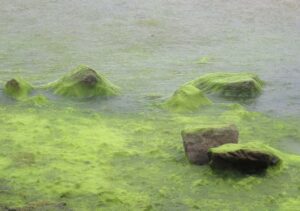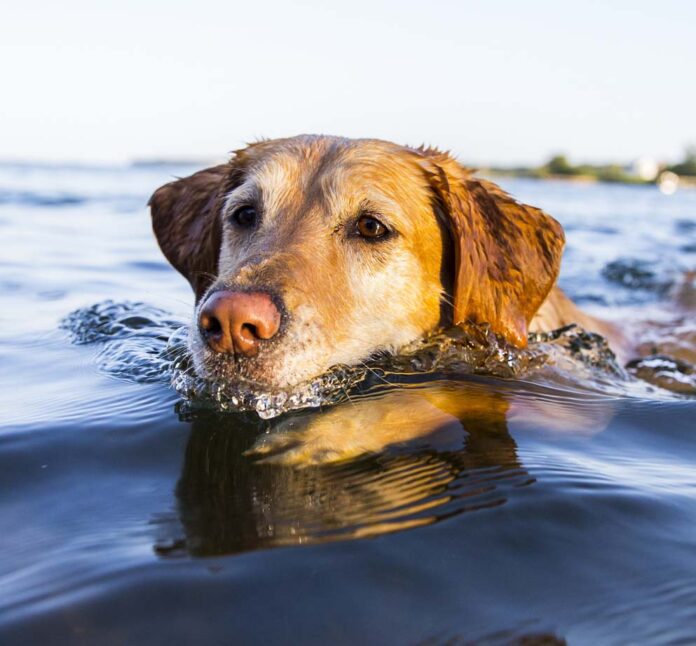Blue-green algae is deadly to dogs. You can identify it through “foam, scum, mats, or streaks” on the water, according to the Centers for Disease Control and Prevention (CDC). The algae produce one of the most powerful natural poisons known.
How Much Blue-Green Algae Is Toxic
A tiny amount of the toxin – literally a few drops – can kill a dog. Dogs who ingest water containing blue-green algae while swimming, lick the water the water off themselves, or just take a quick lap of water can be poisoned. The algae can even be in water sources around your home.
Symptoms Appear Quickly
Blue-green algae begin to affect the dog almost immediately. Symptoms develop quickly, usually within 30 to 60 minutes. Many people report their dogs started getting sick on the drive home, usually with vomiting and diarrhea.
Symptoms of blue-green algae poisoning in dogs include:
- Black, tarry stools
- Diarrhea
- Difficulty breathing
- Disorientation
- Drooling
- Elevated heart rate
- Hives or rash
- Jaundice
- Muscle tremors
- Pale mucous membranes
- Seizures
- Shock
- Stumbling
- Vomiting
- Weakness
If you suspect poisoning, go to a veterinarian immediately. Fatal liver failure occurs quickly. Aggressive veterinary therapy includes IV fluids and plasma to help replenish electrolytes, regulate blood glucose, support organ function, and to prevent shock. Muscle relaxers and anti-seizure drugs are sometimes necessary, too. Sadly, the prognosis related to blue-green algae toxicity is poor.
Blue-green algae contain two types of toxins: microcystins and neurotoxins. Neither has an antidote. The microcystins attack the liver. The neurotoxins begin to paralyze the dog’s respiratory muscles so he can no longer breathe. Immediate treatment with anti-seizure medications and oxygen may help avoid death.
How Can You Protect Your Dog?
Keep him out of any water that you are not familiar with or that looks funky. If you’re going to a park, check for blue-green algae warnings in the area at the Environmental Protection Agency before going. The EPA lists state resources for HABs (harmful algal blooms). Be especially suspicious if the temperatures have been warm and the water is not moving/flowing, as both conditions help the poisonous blooms grow.
If you have any concern that the water your dog was in may be toxic, immediately rinse or hose him with clean water and towel dry him. Wear gloves when you do this because the algae are poisonous to humans, too. Wash your hands when you finish. Follow up with a bath. As stated, any symptom should prompt an immediate trip to the veterinarian.
What Is Blue-Green Algae?
Blue-green algae is cyanobacteria, but not all cyanobacteria are toxins. The problem is that you can’t tell the difference by just looking at the blooms.

Blue-green algae can appear like different colors on the water: green, blue, red, or brown. Some people say it looks like paint streaks. The body of water may look like thick green soup or be cloudy or swampy. The blooms may appear white, if at the end of the life cycle, although the toxins remain in the water for three weeks after the blooms are gone. Even more scary, the algae can be in water that looks clear.
Blue-green algae can’t be seen by the naked eye until the algae clump together. The bacteria thrive in warm, nutrient-rich water. When conditions are right, the algae can grow quickly. It is most common in non-flowing water like lakes and ponds, especially during times of hot weather and little rainfall. However, it can occur at other times of the year, especially as our planet continues to warm.
Cyanobacteria is most common in standing water, versus quickly moving streams and rivers. That’s why the microscopic bacteria can also grow in backyard fountains, garden pots, birdbaths, livestock troughs, and anywhere water is allowed to become stagnant. As a result, it’s important to consider where your pets might be drinking from on your property. Regular emptying and cleaning with a stiff brush is a smart idea if you have vessels on your property that are used to hold water for thirsty animals. Note: Boiling infected water or using chlorine or ultraviolet disinfection will not get rid of cyanobacteria toxins.
Sadly, blue-green algae blooms have killed deer, elk, livestock, cats, horses, and more soon after drinking the water.






Hi,
How do we purify the water for our animals and ourselves if we suspect it is contaminated with blue-green algae?
You said boiling and using chlorine don’t kill it.
If we are in the field and need water to drink, we need to know the answer to this question.
Thanks.
Pat